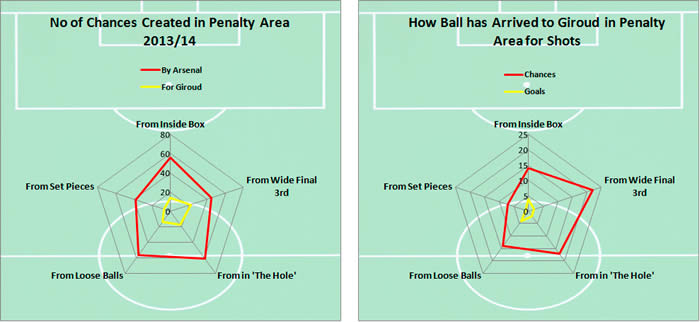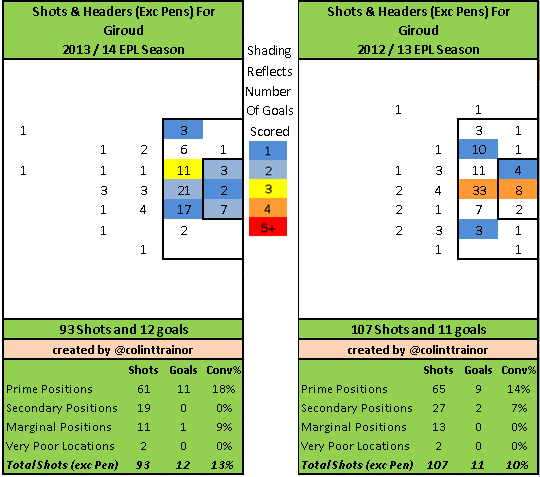As the last line of defence for struggling Norwich City, John Ruddy has had to be at his best to keep out some of the best strikers in the Premier League. He has, however, still had the misfortune of conceding the two goals of the season, an audacious forty-yard volley by Luis Suarez and a “ridiculous” team goal finished by Jack Wilshere. Such was the blur of red and white shirts leading up to the latter goal, in a 4-1 win for Arsenal, Ruddy probably hadn’t realised that the goal was created, not finished, by a striker: Olivier Giroud.
Giroud’s probably not very high on many defenders’ list on the toughest strikers they have faced. He’s a throwback striker; somebody who runs a lot, chases down loose balls, and attempts flick-ons. There are not many like him around anymore and playing in a team like Arsenal’s, who don’t target his height as much as a team like Stoke City, the physical battle will never be as intense. In any case, in the age of zonal-marking, centre-backs find it much easier to play fixed target-men than nippy, wiry types.
But to assume that Giroud is simply just a big guy who is good at holding up the ball with his back to goal would be to severely underestimate him because his role in the side is much more important; to create space for those nippy, wiry types that defenders hate and that Arsenal has in abundance, players like Ozil, Cazorla, Oxlade-Chamberlain.
As French Sports correspondent, Philippe Auclair tells Arseblog, Giroud “loves to play with ‘first intention’ as we say in French; somebody who can flick the ball around the corner, is always looking for a quick solution when the tempo of game has to be accelerated. He’s always looking to create something, a creator in the box. It’s something that Arsenal have been lacking for a while.”
In that sense, Giroud is probably more like Dennis Bergkamp in importance than Alan Smith, who Arsene Wenger likened him to, due to the responsibility he has in build-up. His deft touches, neat flicks and muscular hold-up brings others into play, in a way gluing Arsenal’s technical game together, and that’s what endears him so much to Wenger. When he set up the goal for Wilshere – a outside-of-the-boot flick between two defenders – it was a culmination of all that Arsenal have practiced on the training ground. He runs a lot too, further getting on the manager’s good-books.
The issue though, is that Giroud doesn’t score enough goals. In 43 matches, he has scored only 19 goals this season (although his raw conversion rate is up to 17% from a paltry 10% last season). He says it himself when he says his first role is to “give a lot of effort for the team, to keep the opponent under pressure, to press them, to win the ball fast – that’s what I try to do to help the team,” he tells Amy Lawrence of The Guardian. “After that I try to make some goals.”
Strikers must be creators too. That’s what Giroud does, as typified by his eye of the needle assist to Jack Wilshere against Norwich City and then more recently, in a 4-1 win again, this time against Sunderland. Arsenal rehearse these moves a lot on the training ground, honing technique by using springboards, and perfecting understanding by playing small-sided matches of 5v5, 6v6 etc. and practicing a drill called “through-plays” – a game where there are opponents are simulated by mannequins to “find holes to play diagonal passes.”
Recently, although bubbling for a while, some dissent has seeped through Arsenal fans who feel that creating and scoring at a rate of only 0.5 goals per game isn’t merely enough for a striker playing for a club like Arsenal. It’s true. In an age where fan access has increased considerably, effort isn’t enough; we’re more intellectual and theoretical in what we demand from our players. In the FA Cup quarter-final against Everton, which Arsenal won 4-1; Giroud came off the bench to score the two goals which ultimately put The Gunners through to the next round but the groundwork laid by Yaya Sanogo, the 21 year-old French striker wasn’t lost. He had run Everton ragged and that allowed a fresh Giroud to simply profit from the extra space and tired legs.
Of course, Sanogo’s goalscoring record is also not great, although he’s young, but in the other three games he has started, against Liverpool, Bayern Munich and just last weekend, Wigan Atheltic, he added visible energy to the side with his running of the channels. There’s a lot of value added to a side like Arsenal when a striker does that as it then opens up space for their diminutive midfielders to run into. Giroud, while his link-up play brings others into play, is mainly static, exclusively playing in between the two centre-backs and as such Arsenal’s play can look predictable, and it relies on moves being perfect.
In the match against Sunderland in March, Giroud made an enthusiastic start, scoring the opener by pouncing on a loose ball and generally working the backline. But quickly, he started reverting to type, playing very, very centrally, looking for flicks and lay-offs, and while it didn’t matter much as Arsenal were comfortably playing in front of Sunderland’s defence, it was patently obvious they could have won more comprehensively by exploiting the space behind. But then this happened and all was seemingly vindicated.
In Saturday’s FA Cup semi-final match against Wigan, Yaya Sanogo got a chance to stake his claim and while his shooting was erratic, he showed promising signs. The issue, however, is that it’s hard to tell just how good he will become. His touch was a little inconsistent but he’s very durable, very difficult to bump off the ball. But most promising was his direct play, getting onto the end of set-pieces and crosses, and also looking to spring behind Wigan’s backline even when Arsenal had the ball in defence. The Gunners are reticent to do that, however, lump the ball forwards as Kolo Toure and Sol Campbell might have in yesteryear, even when Giroud is playing. Indeed, the issue of a lack of directness, explosiveness, has been framed at Arsenal all season, even when they were winning.
In the first-half of season they were able to get away with it due to playing with extra commitment and focus and being clinical. But even back then, Wenger admitted that Arsenal probably weren’t “playing that well”. For him, the negativity of opponents’ gameplan made it more difficult for his players to take risks and be “audacious” – key ingredients in his “pass and move” football. In cup matches, and that’s probably why Sanogo has played, Wenger has tried to implant more pace into his side, looking to exploit the nervous energy of the occasion. While that didn’t go exactly to plan against Wigan – Arsenal were a little meek and overawed and as such, allowed their opponents to play – there was a buzz about the way Sanogo played across the line, allowing Oxlade-Chamberlain to run behind. When Giroud came on and both strikers played together, he took a backseat to Sanogo. The one chance he did get, struck well from outside the area and forcing Scott Carson to tip wide, highlighted his lack of pace.
Indeed, that poses the question: had Arsenal had a player like Sanogo, somebody who plays on the offside like though more clinical, like Suarez, for most of the season, how much would it improve Arsenal’s play? It’s argued that this type of striker would be more beneficial to Arsenal style considering they have enough players that like to create but not enough to finish. Besides, Arsenal, being a team stocked with technical players, can feasibly replicate Giroud’s link-up play in different ways: more one-twos between the midfield players predicated on the type of understanding they practice on the training ground, and more wiry, quicker players who can give Arsenal an extra dimension.
Figure 1: How Giroud gets his chances
Via Paul Riley (@footballfactman). It’s arguable that Arsenal don’t use Giroud enough as a target-man (though he is third behind Crouch and Benteke for flick-ons). Indeed, it’s shown by the graphics of where Arsenal create the chances for Giroud, his negligible as a threat from set-pieces but while the bulk of his shots are created from neat interplay out wide or from crosses, he could be more clinical. But that’s also hints at the inconsistent nature of wing-play. If Arsenal are wondering why they are not quite as potent this season (on average they take 13 shots per game, four less than each of the last 3 seasons), perhaps they can point to this contradiction: a pass and move side whose main goalscorer comes alive from chances created from the flanks rather than in the middle (usually these are cuts-backs or crosses flayed to the near post).
As Paul Riley himself says, “in terms of my chance creation model, for the type/volume of shots Giroud has had this season, he’s bang where he should be. Should have 13, has scored 13.”
Arsene Wenger, though, feels safer with Giroud in the side because he balances a team which is he says, “is a bit short, lightweight and more focused on mobility and technical movement so he is the one guy who has that strength and structure for us. That fighting up front is very important for us.” (That means Giroud is sure to start against West Ham to counter the set-piece threat of Andy Carroll).
It’s probably best not to view Giroud as your orthodox striker but rather, as an extension of the midfield – although he’s the player who has the biggest responsibility to finish. When teams become more pure, more focused on keeping the ball, they start to look for unconventional methods of breaking down opponents – look at Messi at Barcelona for example – because they know they’ll deny them space in behind. Instead, the space is in front and Giroud’s link-up play is capable of making space for those players. Perhaps, though, next season we’ll see Arsenal go full circle again look for a “fox in the box” to lead their line…
Figure 2: Where Giroud shoots from
Via Colin Trainor (@colinttrainor). In my analysis of how Giroud can improve his scoring rate from last season, I suggested that he needs to add more mobility to his game and show less reliance on his surprisingly poor heading. Not that much has changed this season except that he is a little less impulsive but still very central. Of course, you’d expect a striker to shoot mostly from these positions but his mobility is surely a factor.




